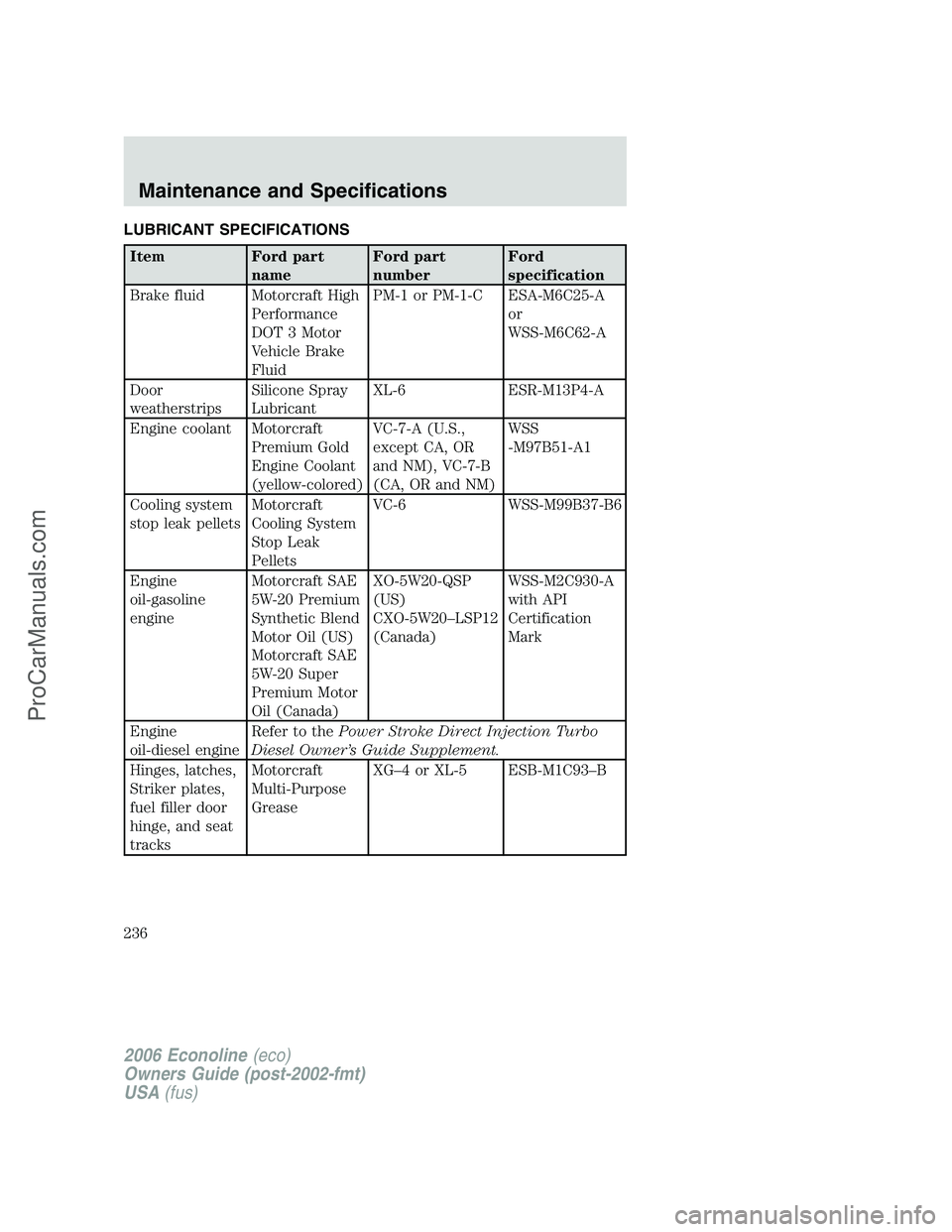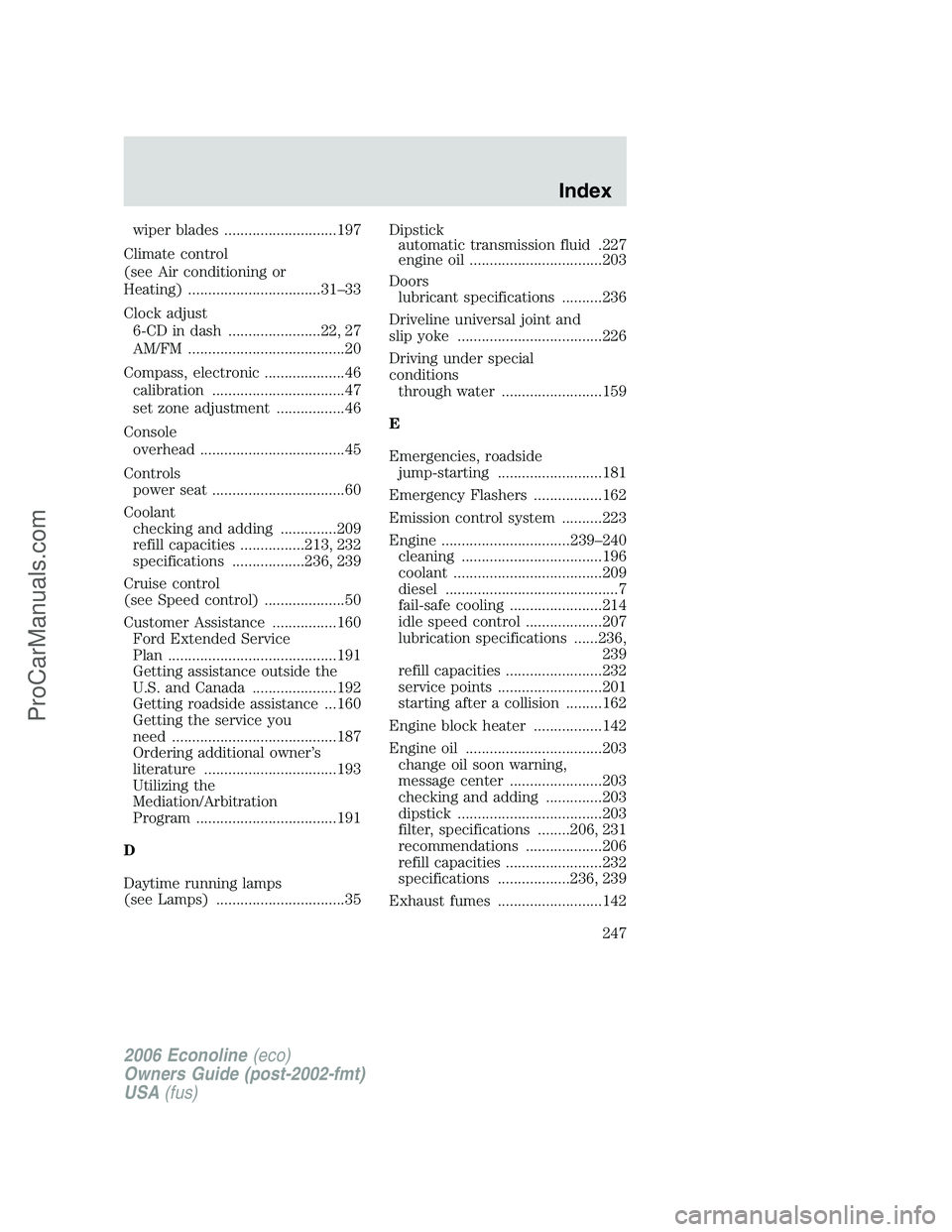2006 FORD E-250 cooling
[x] Cancel search: coolingPage 213 of 256

Used engine coolant should be disposed of in an appropriate
manner. Follow your community’s regulations and standards for recycling
and disposing of automotive fluids.
Coolant refill capacity
To find out how much fluid your vehicle’s cooling system can hold, refer
toRefill capacitiesin this chapter.
Fill your engine coolant reservoir as outlined inAdding engine coolant
in this section.
Severe climates
If you drive in extremely cold climates (less than –34° F [–36° C ]):
•It may be necessary to increase the coolant concentration
above 50%.
•NEVER increase the coolant concentration above 60%.
•Increased engine coolant concentrations above 60% will
decrease the overheat protection characteristics of the engine
coolant and may cause engine damage.
•Refer to the chart on the coolant container to ensure the
coolant concentration in your vehicle will provide adequate
freeze protection at the temperatures in which you drive in the
winter months.
If you drive in extremely hot climates:
•It is still necessary to maintain the coolant concentration
above 40%.
•NEVER decrease the coolant concentration below 40%.
•Decreased engine coolant concentrations below 40% will
decrease the corrosion protection characteristics of the engine
coolant and may cause engine damage.
•Decreased engine coolant concentrations below 40% will
decrease the freeze protection characteristics of the engine
coolant and may cause engine damage.
•Refer to the chart on the coolant container to ensure the
coolant concentration in your vehicle will provide adequate
protection at the temperatures in which you drive.
Vehicles driven year-round in non-extreme climates should use a 50/50
mixture of engine coolant and distilled water for optimum cooling system
and engine protection.
2006 Econoline(eco)
Owners Guide (post-2002-fmt)
USA(fus)
Maintenance and Specifications
213
ProCarManuals.com
Page 214 of 256

What you should know about fail-safe cooling (if equipped)
If the engine coolant supply is depleted, this feature allows the vehicle to
be driven temporarily before incremental component damage is incurred.
The “fail-safe” distance depends on ambient temperatures, vehicle load
and terrain.
How fail-safe cooling works
If the engine begins to overheat:
•The engine coolant temperature
gauge will move to the red (hot)
area.
•The “CHECK GAGE” indicator
light will illuminate.
•The “CHECK GAGE” indicator light will flash when fail-safe cooling
mode has been activated.
If the engine reaches a preset over-temperature condition, the engine
will automatically switch to alternating cylinder operation. Each disabled
cylinder acts as an air pump and cools the engine.
When this occurs the vehicle will still operate. However:
•The engine power will be limited.
•The air conditioning system will be disabled.
Continued operation will increase the engine temperature and the engine
will completely shut down, causing steering and braking effort to
increase.
Once the engine temperature cools, the engine can be re-started. Take
your vehicle to an authorized dealer as soon as possible to minimize
engine damage.
When fail-safe mode is activated
You have limited engine power when in the fail-safe mode, so drive the
vehicle with caution. The vehicle will not be able to maintain high-speed
operation and the engine will run rough. Remember that the engine is
capable of completely shutting down automatically to prevent engine
damage, therefore:
1. Pull off the road as soon as safely possible and turn off the engine.
2. Arrange for the vehicle to be taken to an authorized dealer.
3. If this is not possible, wait a short period for the engine to cool.
4. Check the coolant level and replenish if low.
2006 Econoline(eco)
Owners Guide (post-2002-fmt)
USA(fus)
Maintenance and Specifications
214
ProCarManuals.com
Page 236 of 256

LUBRICANT SPECIFICATIONS
Item Ford part
nameFord part
numberFord
specification
Brake fluid Motorcraft High
Performance
DOT 3 Motor
Vehicle Brake
FluidPM-1 or PM-1-C ESA-M6C25-A
or
WSS-M6C62-A
Door
weatherstripsSilicone Spray
LubricantXL-6 ESR-M13P4-A
Engine coolant Motorcraft
Premium Gold
Engine Coolant
(yellow-colored)VC-7-A (U.S.,
except CA, OR
and NM), VC-7-B
(CA, OR and NM)WSS
-M97B51-A1
Cooling system
stop leak pelletsMotorcraft
Cooling System
Stop Leak
PelletsVC-6 WSS-M99B37-B6
Engine
oil-gasoline
engineMotorcraft SAE
5W-20 Premium
Synthetic Blend
Motor Oil (US)
Motorcraft SAE
5W-20 Super
Premium Motor
Oil (Canada)XO-5W20-QSP
(US)
CXO-5W20–LSP12
(Canada)WSS-M2C930-A
with API
Certification
Mark
Engine
oil-diesel engineRefer to thePower Stroke Direct Injection Turbo
Diesel Owner’s Guide Supplement.
Hinges, latches,
Striker plates,
fuel filler door
hinge, and seat
tracksMotorcraft
Multi-Purpose
GreaseXG–4 or XL-5 ESB-M1C93–B
2006 Econoline(eco)
Owners Guide (post-2002-fmt)
USA(fus)
Maintenance and Specifications
236
ProCarManuals.com
Page 247 of 256

wiper blades ............................197
Climate control
(see Air conditioning or
Heating) .................................31–33
Clock adjust
6-CD in dash .......................22, 27
AM/FM .......................................20
Compass, electronic ....................46
calibration .................................47
set zone adjustment .................46
Console
overhead ....................................45
Controls
power seat .................................60
Coolant
checking and adding ..............209
refill capacities ................213, 232
specifications ..................236, 239
Cruise control
(see Speed control) ....................50
Customer Assistance ................160
Ford Extended Service
Plan ..........................................191
Getting assistance outside the
U.S. and Canada .....................192
Getting roadside assistance ...160
Getting the service you
need .........................................187
Ordering additional owner’s
literature .................................193
Utilizing the
Mediation/Arbitration
Program ...................................191
D
Daytime running lamps
(see Lamps) ................................35Dipstick
automatic transmission fluid .227
engine oil .................................203
Doors
lubricant specifications ..........236
Driveline universal joint and
slip yoke ....................................226
Driving under special
conditions
through water .........................159
E
Emergencies, roadside
jump-starting ..........................181
Emergency Flashers .................162
Emission control system ..........223
Engine ................................239–240
cleaning ...................................196
coolant .....................................209
diesel ...........................................7
fail-safe cooling .......................214
idle speed control ...................207
lubrication specifications ......236,
239
refill capacities ........................232
service points ..........................201
starting after a collision .........162
Engine block heater .................142
Engine oil ..................................203
change oil soon warning,
message center .......................203
checking and adding ..............203
dipstick ....................................203
filter, specifications ........206, 231
recommendations ...................206
refill capacities ........................232
specifications ..................236, 239
Exhaust fumes ..........................142
2006 Econoline(eco)
Owners Guide (post-2002-fmt)
USA(fus)
Index
247
ProCarManuals.com
Page 248 of 256

F
Fail safe cooling ........................214
Fluid capacities .........................232
Four-Wheel Drive vehicles
preparing to drive your
vehicle .....................................148
Fuel ............................................215
calculating fuel economy .......220
cap ...........................................217
capacity ...................................232
choosing the right fuel ...........218
comparisons with EPA fuel
economy estimates .................223
detergent in fuel .....................219
filling your vehicle with
fuel ...........................215, 217, 220
filter, specifications ........215, 231
fuel pump shut-off switch .....162
improving fuel economy ........220
octane rating ...........219, 239–240
quality ......................................219
running out of fuel .................219
safety information relating to
automotive fuels .....................215
Fuses ..........................................164
G
Garage door opener ....................45
Gas cap (see Fuel cap) ............217
Gas mileage
(see Fuel economy) .................220
Gauges .........................................16
H
Hazard flashers .........................162
Headlamps ...................................34
bulb specifications ....................39daytime running lights .............35
flash to pass ..............................35
high beam .................................35
replacing bulbs .........................40
turning on and off ....................34
Heating
heater only system .............31, 33
heating and air conditioning
system .......................................32
Hood ..........................................201
I
Ignition .......................139, 239–240
Infant seats (see Safety seats) ..89
Inspection/maintenance (I/M)
testing ........................................225
Instrument panel
cleaning ...................................197
cluster ........................................12
lighting up panel and
interior .......................................36
J
Jump-starting your vehicle ......181
K
Keys .............................................54
positions of the ignition .........139
L
Lamps
bulb replacement
specifications chart ..................39
daytime running light ...............35
headlamps .................................34
headlamps, flash to pass ..........35
instrument panel, dimming .....36
2006 Econoline(eco)
Owners Guide (post-2002-fmt)
USA(fus)
Index
248
ProCarManuals.com